NOTE:This report on RJK is a compilation of several different sources. Part of it is based upon an oral history (OH) Robert gave Carolyn; the italicized words are directly taken from a document he created for his grandchild’s Fredonia social studies project in Susan Cobb’s class (MH); information was also gleaned from Stan, especially some of the photographs, (SP). Greg and Joe gathered further info. from and about the pilot flimsy and shared that with the family. Some of the information, including pilot flimsys and Direct Orders about the missions was garnered from personal email with Hughes Glantzberg, as well as his site, The 484th Bombardment Group H. Additional research provided from other sources, where noted. Most of the newspaper articles are from the Buffalo News and photographs, I have received at the time of Robert’s death.
Thanks for reading. Please contact me with any questions or for using. You can leave a comment below, and I’ll get back to you. In peace, Carolyn Kieber Grady
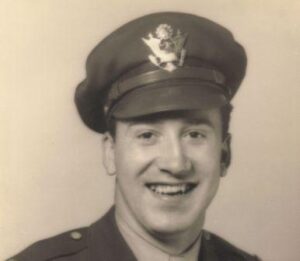 from the Military History of R.J.Kieber, written by Bob for Devin c. 1996: Unfortunately, on Dec. 7, 1941, something happened to change my life, my future and my philosophy. Most of my fellow students felt a responsibility to partake in the conflict crested, in some in one way, and some in another. For myself, I decided to try and graduate in the spring and then make up my mind. I did graduate and returned to Buffalo (1942) to take up a position at National Aniline as a chemist. These people were excused from the draft, but I felt I had to make a more definite move to solve the conflict, which was tearing the world apart, so I enlisted in the Army Air Corps. (MH)
from the Military History of R.J.Kieber, written by Bob for Devin c. 1996: Unfortunately, on Dec. 7, 1941, something happened to change my life, my future and my philosophy. Most of my fellow students felt a responsibility to partake in the conflict crested, in some in one way, and some in another. For myself, I decided to try and graduate in the spring and then make up my mind. I did graduate and returned to Buffalo (1942) to take up a position at National Aniline as a chemist. These people were excused from the draft, but I felt I had to make a more definite move to solve the conflict, which was tearing the world apart, so I enlisted in the Army Air Corps. (MH)

Bob served from 1942 – 1945. He was 23 -25 years old. He piloted a B-24, the Liberator, and sometimes called The Flying Coffin in the 49th Bomb Wing of the Fifteenth Air Force in Italy during WW 2. This was one of five bomb wings in the Fifteenth Air Force. According to the Fifteenth Air Force site:
“In the 18 months of existence the Fifteenth Air Force, operating principally from the complex of airfields in southern Italy, destroyed all gasoline production within its range in southern Europe; knocked out all the major aircraft factories in its sphere; and destroyed 6,282 enemy aircraft in the air and on the ground.
The Fifteenth crippled the enemy’s transportation system over half of once-occupied Europe with repeated fighter and bomber attacks. On occasion it helped disperse enemy counter attacks and spearheaded the advances of our own armies.”
Further, down the chain of command, Bob flew in the 484th Bombardment Group, the 825th Squadron.
The B- 24 was designed and built quickly because a heavy bomber was needed in 1939 after Germany invaded Poland.
The photo at left was taken by RJK from the cockpit of his B-24. Below is a cartoon saved from his collection.
For more information on the B-24, the reader is referred to a Lockheed-Martin account.
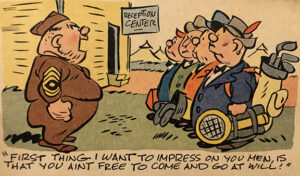
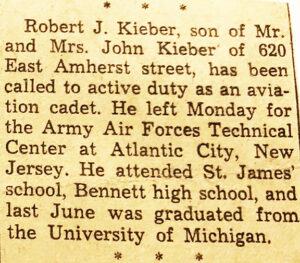 Bob’s life changed, when, in accordance with Special Orders of the U.S. Army Recruiting and Induction Station, he was called to active duty. He was directed to report 1 Feb. 1943 to the Commanding Officer, Air Force Technical Training Command in Atlantic City NJ for Aviation Cadet Basic Training, (SP) or, as Bob said, Indoctrination. Quite an introduction to military life, drilling on the beach, running on the boardwalk, etc. Most unusual, we had Glenn Miller as our Army band who played for dress parades and even for dinner in the hotel to which I was assigned. Mostly, however, life was a complete bore with emphasis on marching, saluting, etc. (MH)
Bob’s life changed, when, in accordance with Special Orders of the U.S. Army Recruiting and Induction Station, he was called to active duty. He was directed to report 1 Feb. 1943 to the Commanding Officer, Air Force Technical Training Command in Atlantic City NJ for Aviation Cadet Basic Training, (SP) or, as Bob said, Indoctrination. Quite an introduction to military life, drilling on the beach, running on the boardwalk, etc. Most unusual, we had Glenn Miller as our Army band who played for dress parades and even for dinner in the hotel to which I was assigned. Mostly, however, life was a complete bore with emphasis on marching, saluting, etc. (MH)
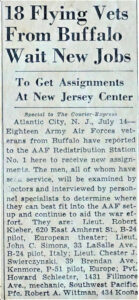 He reported and stayed on the 17th Floor of the hotel. One day, he reported for sick call and they told him since he only had a 102F and not 103F fever that he had to scrub the entire 17th floor with a toothbrush. His new title was Private. (OH)
He reported and stayed on the 17th Floor of the hotel. One day, he reported for sick call and they told him since he only had a 102F and not 103F fever that he had to scrub the entire 17th floor with a toothbrush. His new title was Private. (OH)
Bob often quoted the following lines from The Charge of the Light Brigade by Alfred Lord Tennyson:
April 1943 After two months of Basics, Air-Cadet Kieber was shipped to the School of Aviation at University of Vermont for a few months to pass the time in some hair-brained plan to bring everybody up to speed in such things as map-reading, math, etc. Again, long hours of drill and parades. The Controlled Indoctrination Flight Course began with simple aircraft familiarization and inspection, starting and warm-up procedures, stopping and parking. It progressed to take-offs, glides, climbing turns, S-turns, and various coordination exercises. Finally, the training peaked with cross-wind take-offs and landings, steep-turn and high speed stalls, go-arounds, in air-fire, and bail-out procedures. 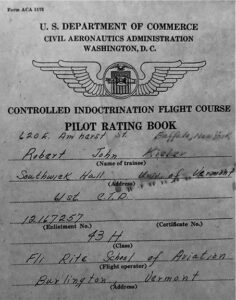 According to his Pilot Ranking Book, Air Cadet Kieber was noted to be ” alert, very observant,….moved at ease in the ship…..confident and cooperative….has good coordination and knows the pattern family well.” (SP)
According to his Pilot Ranking Book, Air Cadet Kieber was noted to be ” alert, very observant,….moved at ease in the ship…..confident and cooperative….has good coordination and knows the pattern family well.” (SP)
The military had them take “university classes” in math and writing. They taught them things like 2+2. Also, had them marching and marching some more. It seemed to be a money-making area since they made them all buy uniforms that they had to get rid of at the next duty station.(MH)
August 1943 Finally, we were sent to Nashville, TN, to undergo a long process of classification which took several weeks. The concept was to separate future flying cadets from those not qualified (on the basis of medical, 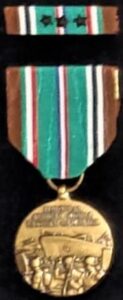 psychological, etc.) and to also try and identify who would be pilots, navigators, bombadiers, gunners,etc. This testing included long medical trials such as opthamology to determine color blindness, depth perception, peripheral vision, etc. A great many young men failed to make the grade in this process. Anyway, This is where it was decided through more crazy tests, whether you would be a pilot. Robert at first “failed” the test when they asked him “when was the last time you had sex” and he answered “never.” He then went to his barracks where his friend told him, “what are you nuts, just go back tomorrow and tell them you had sex last night.” He said “but I hadn’t” and his friend responded, “does not matter, if you want to be a pilot you need to say that you did.” So the next day, he went back and when the instructor asked him again “when was the last time you had sex” he said “last night” and don’t you know, they told him congratulations you are a pilot!
psychological, etc.) and to also try and identify who would be pilots, navigators, bombadiers, gunners,etc. This testing included long medical trials such as opthamology to determine color blindness, depth perception, peripheral vision, etc. A great many young men failed to make the grade in this process. Anyway, This is where it was decided through more crazy tests, whether you would be a pilot. Robert at first “failed” the test when they asked him “when was the last time you had sex” and he answered “never.” He then went to his barracks where his friend told him, “what are you nuts, just go back tomorrow and tell them you had sex last night.” He said “but I hadn’t” and his friend responded, “does not matter, if you want to be a pilot you need to say that you did.” So the next day, he went back and when the instructor asked him again “when was the last time you had sex” he said “last night” and don’t you know, they told him congratulations you are a pilot!
Green ribbon with stars and medal: European Campaign with 3 combat battle stars
Robert always said “the ground crew was great and the food was ok.”
Another aspect he recounted was: It was the little things that made life difficult during the war.The military went through a number of permutations for what to do with “waste” on the plane during their runs. It took them 3 bad tries until they came up with the final product. The pilots all suffered in the mean time. (OH)
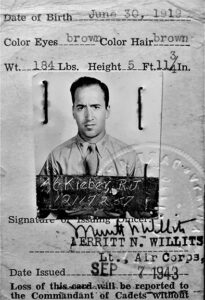 After about two months we were finally called “cadets” and sent in August 1943 to Maxwell Field in Montgomery Alabama for 1st year of cadet training. This period was intended to be the final preparation for life in the Army Air Corps as an officer, a gentleman, and a flyboy. The training included proper eating technique, politeness, aircraft identification, map reading, navigation, and other related topics. It was very intense; I was in the class of 44D and there was another class in front of me, and another coming up behind. The war was short of flight crews and the training intensified.
After about two months we were finally called “cadets” and sent in August 1943 to Maxwell Field in Montgomery Alabama for 1st year of cadet training. This period was intended to be the final preparation for life in the Army Air Corps as an officer, a gentleman, and a flyboy. The training included proper eating technique, politeness, aircraft identification, map reading, navigation, and other related topics. It was very intense; I was in the class of 44D and there was another class in front of me, and another coming up behind. The war was short of flight crews and the training intensified.
Following Maxwell Field, we again had a cut-down of some cadets who did not make the grade. The rest of us were shipped to Primary Flight Schools at various places and mine was Albany, Georgia for 2 months. The particular field I was assigned to was a civilian airfield that had been taken over by the Air Force. We were trained in Stearman PT-17, open cockpit planes. The program required us to solo in approximately 10 hours of instruction and then learn to control the aircraft by doing aeronautical maneuvers such as loops, slow rolls, snap rolls, spins, etc. Also included was navigation training and cross country flying. In addition, there were approximately 3-4 hours of ground classes per day. At the end of a two month period. we were given very strict flight checks by the military check pilots. Unfortunately for some, they did not make it and were re-assigned. Note: We had to buy new uniforms since the cousin of the commanding officer sold them. 
From Chanute Field, LT. Kieber proceeded in May 1944 to the 18th Altitude Training Unit in Selfridge, MI. for “Oxygen Indoctrination.” There, he completed the course with the 18th Altitude Training Unit, which included lectures on the physiology of altitude and oxygen equipment, as well as “Indoctrination Flights in the Altitude Chamber.” There, he was induced with mild anoxia at 20,000 feet, acute anoxia at 30,000 feet, and a demonstration of “bends and gas pains” at 38,000 feet. (SP)
August 1944 Having passed primary, I was sent to Greenville, Mississippi for Basic Flight Training in B-15 aircraft. This was a big step up and included closed canopy cockpits, and a much more powerful engine. We now began a more complicated instrument study, including instrument flying (which included many hours in a Link trainer). Also, we were introduced to formation flying and a few other niceties. If you could pass this level, you were able to call yourself a pilot. Not to be redundant, we also attended four hours of ground school each day and military drilling. For those who passed, there was now another separation into single engine pilots (essentially fighter pilots) and multi-engine pilots, most of whom became bomber pilots, but others piloted transport planes.(MH) At one point, they lined them all up, made them strip and then went down the line and gave them all a series of inoculations. Bob, being the microbiologist, refused, since of course, they used the same needle for all.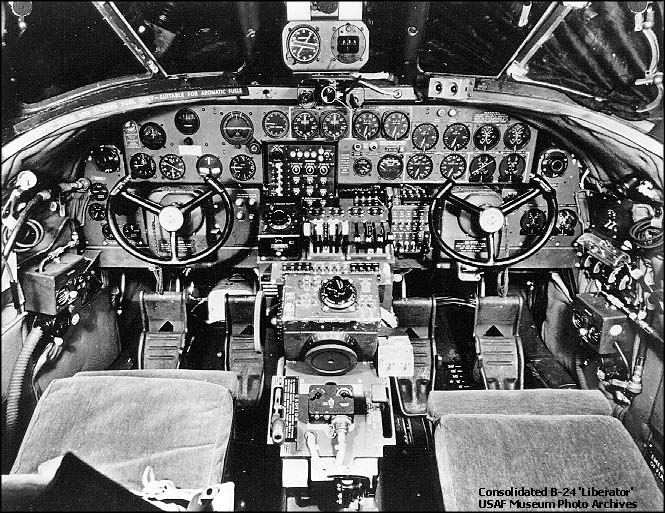
Photo: Inside the cockpit of a B-24
September 1944 Since I was chosen to move on, I was sent to Advanced Pilot Training in George Field, Rantoul, Illinois. Again, they made them buy new uniforms for some reason. Here we were to train in twin-engine A-10 aircraft. This was a new experience, handling two engines at a time and flying a much bigger aircraft. The training involved long flights to intensify our navigational skills as well as many many hours of instrument flying. Needless to say, ground training was also included. This took about two months and if we were successful, we graduated from cadet school, became second lieutenants, and officially were declared pilots. Among other things, this meant an increase in wages from the $21 /month we had in pre-flight to the $50 we received in cadet school and now a magnificent $125/month. (MH)
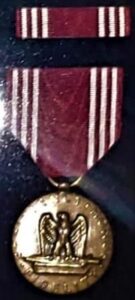 November 1944 And now, another move,to Chanute Field in Champaign, Illinois for intensive Training in four engine aircraft (B-24 in my case). This was a real challenge, even the size of the plane was enough to scare the daylights out of us. We began to study the plane from the inside out, being tested on our ability to identify (while blindfolded) all of the instruments on the panel, all of the switches and all of the power controls. Even for young men, this was a challenge, (Note: Bob was writing this when he was 80 for his grandson). I remember even being led back through the bombbay and being asked to reach out and identify each ofthe many cables running along the fuselage. Also, included was intensive ground training in tactics, navigation, plane recognition, leadership, etc. It was no picnic. Even the problem of learning to fly with an oxygen mask was not a walk in the park, but a necessary bit of knowledge. An interesting sidelight — I was able to fly the plane on a routine navigation mission and show my Mom and Dad what had become of their son.(MH)
November 1944 And now, another move,to Chanute Field in Champaign, Illinois for intensive Training in four engine aircraft (B-24 in my case). This was a real challenge, even the size of the plane was enough to scare the daylights out of us. We began to study the plane from the inside out, being tested on our ability to identify (while blindfolded) all of the instruments on the panel, all of the switches and all of the power controls. Even for young men, this was a challenge, (Note: Bob was writing this when he was 80 for his grandson). I remember even being led back through the bombbay and being asked to reach out and identify each ofthe many cables running along the fuselage. Also, included was intensive ground training in tactics, navigation, plane recognition, leadership, etc. It was no picnic. Even the problem of learning to fly with an oxygen mask was not a walk in the park, but a necessary bit of knowledge. An interesting sidelight — I was able to fly the plane on a routine navigation mission and show my Mom and Dad what had become of their son.(MH)
His Pilot Transition Training Record, signed by the Squadron Commander, noted that he “flies with ease and confidence.” (SP)
Pictured above: The red ribbon with medal that says: Honor, Fidelity, Eficiency was awarded for Robert’s Good Conduct.
December 1944 After two months, we were finally graduated and sent to Worcester, Mass assemble and meet our crew. This included co-pilot, navigator, bombadier, crew chief, radio operator, nose gunner, tail gunner, upper turret gunner, waist gunner, and ball turret gunner. After some time together, there was an opportunity to get to know each other because the challenge of a crew was to act as a single unit.
Pictured, from rear left: Lt. Kieber, pilot, Joe Orelli, co-pilot, Forest Kitson, navigator, Ronald Perrault, tail gunner, Irving Rosen, crew chief
Front Row: Francis Urbanek, waist gunner, Richard McCarty, ball turrett gunner, Stanley Parda, radioman, Chester Peacock, nose gunner
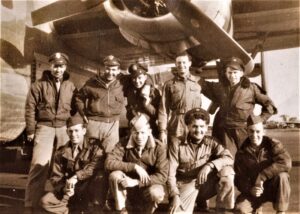 As a pilot, Robert, “Was essentially overlord of the Liberator and ultimately held responsible for the actions and relative well-being of the rest of his crew. The pilot maintained the Liberator’s position in flight and was called upon to deliver the aircraft to the target area and back and make split-second decisions based on actions to keep his crew alive.” (militaryfactory.com )
As a pilot, Robert, “Was essentially overlord of the Liberator and ultimately held responsible for the actions and relative well-being of the rest of his crew. The pilot maintained the Liberator’s position in flight and was called upon to deliver the aircraft to the target area and back and make split-second decisions based on actions to keep his crew alive.” (militaryfactory.com )
Flying Wing: When Carolyn mentioned in conversation the famous Tuskegee Airmen, Robert recalled how they flew wing for him on several occasions and remarked that they were absolutely top-notch. He always felt safe when they were on the mission.(OH)
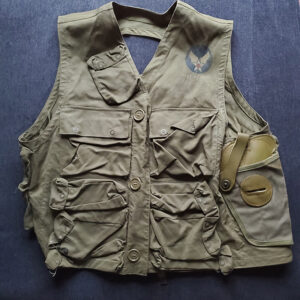 We then were transported to Charleston, SC to begin our final stage of training which included actual gun firing at airborne targets, bombing on the range, strict formation flying, navigation, etc, etc. During all of these two months, we were to become a ships company with a single commander who would be respected and obeyed by all aboard. Since I was an old man of 24, perhaps it was easier for me. However, problems did arise, i.e. my ball turret gunner became air sick on each flight and tried to hide it from me, fearing that he might be grounded. I was able to help him out of this problem and he became one of my most trusted men. We were also struck by a hurricane during our stay and one of the most questionable duties of my career was to sit in the plane all night long and keep turning it in the wind. Wow!
We then were transported to Charleston, SC to begin our final stage of training which included actual gun firing at airborne targets, bombing on the range, strict formation flying, navigation, etc, etc. During all of these two months, we were to become a ships company with a single commander who would be respected and obeyed by all aboard. Since I was an old man of 24, perhaps it was easier for me. However, problems did arise, i.e. my ball turret gunner became air sick on each flight and tried to hide it from me, fearing that he might be grounded. I was able to help him out of this problem and he became one of my most trusted men. We were also struck by a hurricane during our stay and one of the most questionable duties of my career was to sit in the plane all night long and keep turning it in the wind. Wow!
After all the multitude of training was over, we were sent to Mitchell Field on Long Island NY to await our orders for overseas. This wasn’t too bad since we had liberty each evening while we were there — about 2 weeks. (MH)
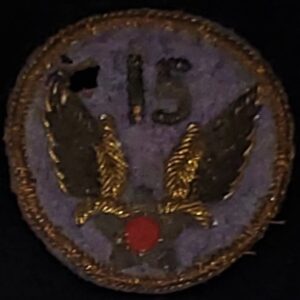 Finally, we received our orders to proceed — 18 Jan. 1945. We flew in the B-24 assigned to our crew to Bangor, Maine; stayed overnight, proceeded to fly to Bermuda; stayed overnight; flew to Lagens Field, Azores, stayed overnight, flew to Marrakech, French Morocco, then to Tunis, Tunisia. Then on to Manduria, Italy, with assignment at the 825th Bomber Squadron (Torretto Airfield), Cerignola, Italy, arriving on 31 January 1945. He was now part of the 484th Bombardment Group, 15th U.S.Army Air Force. Just incidently, this was the type of exercise for which all of the navigation and cross-country flights were to prepare us. The weather across the Atlantic was one long thunderstorm during this flight and and several planes were lost and their crews were lost. (MH)
Finally, we received our orders to proceed — 18 Jan. 1945. We flew in the B-24 assigned to our crew to Bangor, Maine; stayed overnight, proceeded to fly to Bermuda; stayed overnight; flew to Lagens Field, Azores, stayed overnight, flew to Marrakech, French Morocco, then to Tunis, Tunisia. Then on to Manduria, Italy, with assignment at the 825th Bomber Squadron (Torretto Airfield), Cerignola, Italy, arriving on 31 January 1945. He was now part of the 484th Bombardment Group, 15th U.S.Army Air Force. Just incidently, this was the type of exercise for which all of the navigation and cross-country flights were to prepare us. The weather across the Atlantic was one long thunderstorm during this flight and and several planes were lost and their crews were lost. (MH)
Torretto Air Base, also known as Cerignola #3, was a semi-permanent heavy bomber airfield built by the U.S. Army Corps of Engineers beginning in Sept. 1943. Located 9 miles SW of Apulia, Italy, it utilized two perforated steel planking runways with extensive taxiway and hardstand parking areas. And, of course, a steel control tower.
When arrived in Cerignola the Supply Sergeant sold them their cots and palettes to sleep on since the ground was a mud pit. It was very cold and they had to jerry rig a canister with gasoline under the tent, since their supply sergeant would not give them the blankets that they were authorized. After settling in our tents (no floors, just mud) with no heat in the middle of the winter with snow on the ground, we awaited our first mission.(MH)
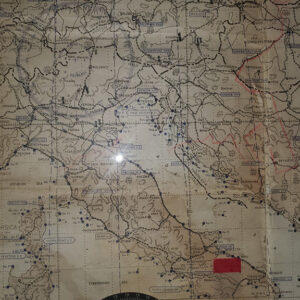
On 19 February 1945, Kieber participated as a co-pilot in his first combat bomber flight on an attack against Graz, Austria. This was the marshalling yard in Graz. Austria. To say I was surprised for this event would be an understatement. (MH) The target was originally Vienna South Station, but it was necessary for the group to hit the first alternate, Graz, because a strong head wind caused excessive fuel consumption, making it impossible to reach Vienna and return. (484th)
This was a 7 hour, 55 minute mission. (SP)
When he went on his first bombing run as a co-pilot, before he went up with his actual crew, he saw some black smoke and asked the pilot “what is all that black stuff” and the pilot said it was flack and that was where their target was, they were heading straight into it. The next bombing run was his, where they sustained 45 hits to the plane where they had to cut out the guns and get rid of all the ammunition.
All crewmembers extremely tired: Bob, in later years, reported that his co-pilot fell asleep all the time. This was the man with the map who was supposed to be telling Bob where to go. It’s a wonder they ever made it to their destination.
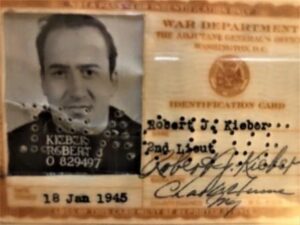 On 25 February 1945, 2LT Kieber, flew his 2nd mission, now as the pilot, in a combat bombing of Linz, Austria. 34.5 tons of bombs were dropped as the Nazis put up a strong smoke screen to hamper USAAF targeting. (SP) Flying at altitude with the temperature well below freezing (temp dropped one degree for each 1000 ft. of altitude andno pressurization in the cabin was a real challenge. Then, on the way, we were attacked by German fighters and lost several planes. But, the real rude awakening came as we turned onto the final leg to approach the target. At this time, the Germans had instituted a “box” defense with anti-aircraft guns. Since they knew we had to hold course and altitude steady on the bomb run in order for the Norden bombsights to work properly, they fired shells in a “box” approximately 2000 ft. x 2000 ft. x 2000 foot. We had to fly through this and as we approached, it looked like a dark storm cloud with bright lights exploding in the middle. As we finally entered the area, which some writers have described as “hell,” the ship was shaken severely and the reason for prayer was evident. We came out of the far side “after dropping bombs and made a sweeping turn for home. When we finally landed, four hours later, I was so exhausted that I had to be helped from the pilot’s seat and off the plane. On the ground, I walked around and examined the ship and found 43 holes of various sizes in the fuselage and wings. Was I scared during all of this? Damn right I was, although I wasn’t supposed to let my crew know.(MH)
On 25 February 1945, 2LT Kieber, flew his 2nd mission, now as the pilot, in a combat bombing of Linz, Austria. 34.5 tons of bombs were dropped as the Nazis put up a strong smoke screen to hamper USAAF targeting. (SP) Flying at altitude with the temperature well below freezing (temp dropped one degree for each 1000 ft. of altitude andno pressurization in the cabin was a real challenge. Then, on the way, we were attacked by German fighters and lost several planes. But, the real rude awakening came as we turned onto the final leg to approach the target. At this time, the Germans had instituted a “box” defense with anti-aircraft guns. Since they knew we had to hold course and altitude steady on the bomb run in order for the Norden bombsights to work properly, they fired shells in a “box” approximately 2000 ft. x 2000 ft. x 2000 foot. We had to fly through this and as we approached, it looked like a dark storm cloud with bright lights exploding in the middle. As we finally entered the area, which some writers have described as “hell,” the ship was shaken severely and the reason for prayer was evident. We came out of the far side “after dropping bombs and made a sweeping turn for home. When we finally landed, four hours later, I was so exhausted that I had to be helped from the pilot’s seat and off the plane. On the ground, I walked around and examined the ship and found 43 holes of various sizes in the fuselage and wings. Was I scared during all of this? Damn right I was, although I wasn’t supposed to let my crew know.(MH)
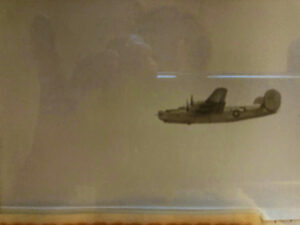 On 28 February 1945 the target was Bressanone, Italy. This area was part of the Brenner Pass bombardment— a strategic pass through the Alps which forms the border between Italy and Austria. The Pass was a major supply route into Italy and the Nazis defended it heavily. They also had an advanced warning system, so that there were practically no surprise attacks. More than half of the Allied Bombing missions hit flak from anti-aircraft guns. “However, through these efforts, much of the Brenner was made impassable during the month.” This information and the quotation are from an interesting account of what happened, Flak Guns in the Brenner Pass by Frank B. Dean. Also, Beneath a Scarlet Sky by Mark Sullivan is an excellent novel that portrays the German and Italian, centered on the Italian Resistance sides, of the story. Highly Recommended.
On 28 February 1945 the target was Bressanone, Italy. This area was part of the Brenner Pass bombardment— a strategic pass through the Alps which forms the border between Italy and Austria. The Pass was a major supply route into Italy and the Nazis defended it heavily. They also had an advanced warning system, so that there were practically no surprise attacks. More than half of the Allied Bombing missions hit flak from anti-aircraft guns. “However, through these efforts, much of the Brenner was made impassable during the month.” This information and the quotation are from an interesting account of what happened, Flak Guns in the Brenner Pass by Frank B. Dean. Also, Beneath a Scarlet Sky by Mark Sullivan is an excellent novel that portrays the German and Italian, centered on the Italian Resistance sides, of the story. Highly Recommended.
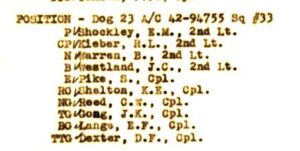 On 2 March 1945 Robert and his crew returned to Linz. His target now was the Benzol Plant. Robert and his crew were listed as having flown–as pictured at right–for 2 March 1945. (484th)
On 2 March 1945 Robert and his crew returned to Linz. His target now was the Benzol Plant. Robert and his crew were listed as having flown–as pictured at right–for 2 March 1945. (484th)
Need for Prayers: Robert had a crewman who saw him praying before a bombing run. The crewman asked what Bob was doing and he answered that he was praying for all the people he was going to hurt by the bombing. By the time they made their final run, ALL the crew were praying for the people in the cities they bombed. For many years after the war, they supported a school in an Italian village that had been destroyed by their bombs. (OH) A Holy Card of the “Prayer to our Divine Protector” was found in Bob’s personal effects when he died. On the front was pictured servicemen, Jesus, and an American flag.
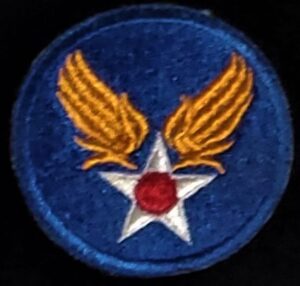 On 4 March 1945 2LT Kieber and 32 other B-24’s attacked Graz main Marshaling Yards in Austria. This attack was of vital importance to further disrupt the already disorganized rail system from Vienna to the Hungarian front and south to Yugoslavia.
On 4 March 1945 2LT Kieber and 32 other B-24’s attacked Graz main Marshaling Yards in Austria. This attack was of vital importance to further disrupt the already disorganized rail system from Vienna to the Hungarian front and south to Yugoslavia.
At right is Robert’s shoulder sleeve insignia that was worn by all members of the U.S. Army Air Forces: The ultramarine disk represents the The ultramarine disk represents the medium in which the Air Forces operated, and the white star with red disk was the identifying symbol of U.S. Army and Navy airplanes since 1921. (The red disk was removed from aircraft markings in 1942 to prevent confusion with Japanese insignia.) The golden wings symbolize victorious operation. (AFH)
On 8 March 1945 39 aircraft took off to bomb the RR cars at Hegyshalom marshalling yards in Hungary. The importance of this attack wsa the disruption and disorganization of military supplies and traffic enroute to the front and its destruction would be an effective support for the Russian ground troops. Two forces were flown this day and good results were obtained by both.
Dangerous Turbulence: He had a bombardier who used to urinate on the bombs, saying “Take this Hitler.” One day, he wound up with his penis stuck to the freezing cold bomb when the plane bumped during turbulence. His crewmates had to either pee themselves to free it, or, as another family member remembers, pour a cup of warm coffee to free it.
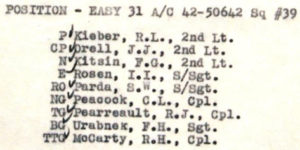 Regensberg, Germany’s railyards were the target on 13 March 1945. Regensburg was one of three main enemy fighter manufacturing complexes. (15thaf.org) “28 of our aircraft took off to bomb the Regensburg Marshalling Yards in Germany. Again due to complete cloud cover over the target it was necessary to bomb by PFF methods.” (484th) The PFF were Pathfinders– the area to be targeted was marked on the ground with flares, etc.
Regensberg, Germany’s railyards were the target on 13 March 1945. Regensburg was one of three main enemy fighter manufacturing complexes. (15thaf.org) “28 of our aircraft took off to bomb the Regensburg Marshalling Yards in Germany. Again due to complete cloud cover over the target it was necessary to bomb by PFF methods.” (484th) The PFF were Pathfinders– the area to be targeted was marked on the ground with flares, etc.
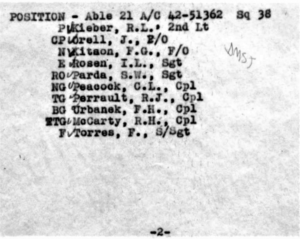 On 16 March 1945, 35 of aircraft took off to bomb the Moosierbaum Oil Refinery in Austria. “On this date, Moosierbaum was one of five remaining refineries producing in the Vienna area and the objective was to destroy the remaining, producing facilities and hamper the repair of the others previously damaged. Flak encountered was dense, heavy and accurate.”
On 16 March 1945, 35 of aircraft took off to bomb the Moosierbaum Oil Refinery in Austria. “On this date, Moosierbaum was one of five remaining refineries producing in the Vienna area and the objective was to destroy the remaining, producing facilities and hamper the repair of the others previously damaged. Flak encountered was dense, heavy and accurate.”
” Because the enemy needed to protect the oil refineries and installations, flak cannons were mounted on railway flat cars and were moved about as needed but also to fool our intelligence. The flak trains were often hid in railway tunnels at night for just this purpose. The next day they would be somewhere else.” (484th about page).
Above is a copy of the Direct Orders for Robert and his crew for 16 March Moosierbaum Oil Refinery. On the Pilot Flimsy, it was noted that he would have a camera onboard and that his plane would be part of the first attack group. (484th)
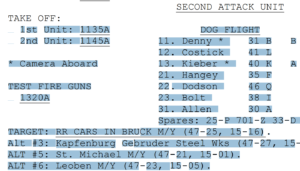 1 April 1945 “was a target of opportunity. A run was made on the primary target, the Bruck railroad yards, but cloud covering made it necessary to abandon it. Instead, a PFF run was made on the target at Villach, Austria.” (484th). Robert flew in the 2nd attack unit on this mission. Again, Kieber had a camera onboard.
1 April 1945 “was a target of opportunity. A run was made on the primary target, the Bruck railroad yards, but cloud covering made it necessary to abandon it. Instead, a PFF run was made on the target at Villach, Austria.” (484th). Robert flew in the 2nd attack unit on this mission. Again, Kieber had a camera onboard.
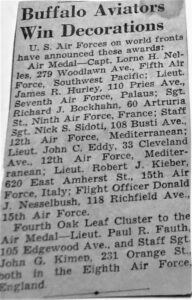 6 April 1945 the mission was Brescia-Bredia, Italy. “The day before, Brescia West M/Y was targeted because “Reports indicated that the cars at Brescia were filled with German war equipment and Italian machinery being moved to Germany. ” The next day, “A phase of the production of ammunition was done at this plant (Brescia – Bredia Small Arms Plant), so it was picked as the target for the 484th Bomb Group. All bombing was done visually by boxes in trail. 27 planes dropped 65 tons of bombs on the plant with good results.” (484th) Lt. Kieber and his crew were in the Second Attack Unit, Easy Flight.
6 April 1945 the mission was Brescia-Bredia, Italy. “The day before, Brescia West M/Y was targeted because “Reports indicated that the cars at Brescia were filled with German war equipment and Italian machinery being moved to Germany. ” The next day, “A phase of the production of ammunition was done at this plant (Brescia – Bredia Small Arms Plant), so it was picked as the target for the 484th Bomb Group. All bombing was done visually by boxes in trail. 27 planes dropped 65 tons of bombs on the plant with good results.” (484th) Lt. Kieber and his crew were in the Second Attack Unit, Easy Flight.
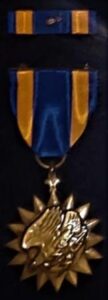 Returning Over the Alps: While returning from a mission north of the Alps, Lieutenant Kieber’s B-24 developed engine troubles — one of the engines stopped working. Bob grew concerned whether the aircraft would be able to make it over the mountains. He directed the crew to throw ancillary equipment out of the plane, and even to use a hatchet to cut out heavy equipment that might prevent their return. The effort worked! They returned to base safely. (SP)
Returning Over the Alps: While returning from a mission north of the Alps, Lieutenant Kieber’s B-24 developed engine troubles — one of the engines stopped working. Bob grew concerned whether the aircraft would be able to make it over the mountains. He directed the crew to throw ancillary equipment out of the plane, and even to use a hatchet to cut out heavy equipment that might prevent their return. The effort worked! They returned to base safely. (SP)
Author’s note: we are not certain when Robert received the Air Medal, but The Air Medal, according to the Fact Sheet from the US Air Force, was created in 1942 and was awarded for “single acts of heroism or meritorious achievements while participating in aerial flight.”
9 & 10 April 1945 Eighth Army Ground Support, Bologna, Italy. Area Apple. ” It was a mission in direct support of the British Eighth Army. An area in front of the troops was saturated with bombs, enabling the Eighth Army to move up into the Po Valley. For safety, the friendly troops were well-marked with signs placed on the ground…. This mission was highly successful, and received commendation from the British Army. ” On the 10th, the mission was the same, but with a different area (Area Baker targeted). 21 B-24s in two attack waves were dispatched by the 484th BG. One returned early. The Eighth Army had advanced, and so did the 15th Air Force. ”
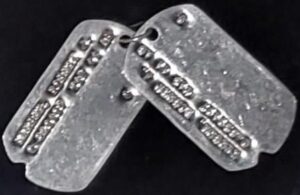 Photo of Robert Kieber’s dog tags. … an aluminum Identification Tag, the size of a silver Half Dollar, stamped with the name, rank, company, regiment, or corps of the wearer; it will be worn by each Officer and Enlisted Man of the Army whenever the field kit is worn; it will be suspended from the neck, underneath the clothing by means of a cord or thong passed through a small hole in the Tag; it is further described as being part of the uniform…” From the US Medical Research Center Robert’s serial number was (0-829497).
Photo of Robert Kieber’s dog tags. … an aluminum Identification Tag, the size of a silver Half Dollar, stamped with the name, rank, company, regiment, or corps of the wearer; it will be worn by each Officer and Enlisted Man of the Army whenever the field kit is worn; it will be suspended from the neck, underneath the clothing by means of a cord or thong passed through a small hole in the Tag; it is further described as being part of the uniform…” From the US Medical Research Center Robert’s serial number was (0-829497).
12 April 1945 St. Veit Railroad Bridge, Italy
“27 aircraft were dispatched by the 484th BG to bomb one of the lesser important communication targets, but still was one more obstacle in the supply route of the enemy. The bridge was well hit.” (484th) Pictured is the crew list for 12 April 1945.
Crew shot in action: Bob, jr. remembers the story told to him of how one of Robert’s crewmembers was shot in the stomach and, while flying the plane with one hand, Robert had to hold the person’s guts in, until safely returned to base. crewmember held onhis owmn
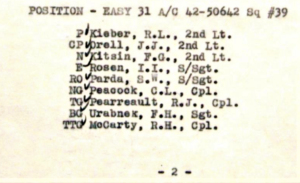 19 April 1945 Avisio Railroad Viaduct, and Railroad Diversion Bridge, Treato, Italy. “The group went over the primary target, the Avisio RR Viaduct, but smoke from the preceding groups made it impossible for the bombardier to pick up the aiming point. The alternate was picked up, but due to a freak accident the bombs fell short and to the left. A burst of flak between the lead ship and the deputy lead the vertical gyros to tumble on both ships. The 484thBG sent out 25 B-24s dropping 55.5 tons of bombs.”
19 April 1945 Avisio Railroad Viaduct, and Railroad Diversion Bridge, Treato, Italy. “The group went over the primary target, the Avisio RR Viaduct, but smoke from the preceding groups made it impossible for the bombardier to pick up the aiming point. The alternate was picked up, but due to a freak accident the bombs fell short and to the left. A burst of flak between the lead ship and the deputy lead the vertical gyros to tumble on both ships. The 484thBG sent out 25 B-24s dropping 55.5 tons of bombs.”
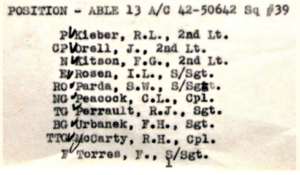 20 April 1945 Luisa Railroad Bridge, Italy. “The target was easily picked up and all hit with compact patterns. The center span of the bridge was knocked out. This was a highly successful mission. 40 aircraft were sent out, 2 returned early. 92 tons of bombs were dropped.” (484)
20 April 1945 Luisa Railroad Bridge, Italy. “The target was easily picked up and all hit with compact patterns. The center span of the bridge was knocked out. This was a highly successful mission. 40 aircraft were sent out, 2 returned early. 92 tons of bombs were dropped.” (484)
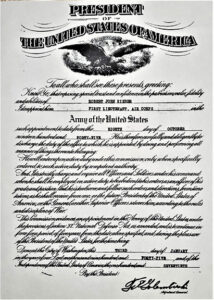 21 April 1945 Robert is promoted to First Lieutenant. IAW Special Orders Number 111, Headquarters, Fifteenth Air Force, U.S. Army: “by the direction of the President and … having clearly demonstrated fitness for promotion by outstanding performance in actual combat.” (SP)
21 April 1945 Robert is promoted to First Lieutenant. IAW Special Orders Number 111, Headquarters, Fifteenth Air Force, U.S. Army: “by the direction of the President and … having clearly demonstrated fitness for promotion by outstanding performance in actual combat.” (SP)
 Robert’s Final Mission: 23 April 1945 Badia Railroad Bridge, Italy. “Because of the rapid advance of the Allies into Italy, the Germans were in a state of disorganization. The 15th Air Force was endeavering to disrupt supply lines in order to further that disorganization. The approaches to the bridge were destroyed, and one box destroyed a span.” (484th)
Robert’s Final Mission: 23 April 1945 Badia Railroad Bridge, Italy. “Because of the rapid advance of the Allies into Italy, the Germans were in a state of disorganization. The 15th Air Force was endeavering to disrupt supply lines in order to further that disorganization. The approaches to the bridge were destroyed, and one box destroyed a span.” (484th)
Above is Bob’s crew list for this, his final mission in the war.
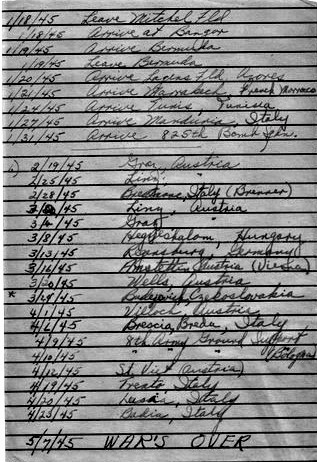 All of this produced a profound change in your outlook on life. Many men who had never prayed, found the need, many became sober at the thought of the terrible havoc that this was producing. For myself, I asked God to make my life worthwhile and to be of some use to others. I also asked that if I were to survive, that I might father a large family to make up for the many young men, many of them my friends, who lost their lives. I also realized that the concepts which we so freely accept in our country are not gifts, but must be secured with a price. This certainly became a factor in the way I look at life. I have never forgotten some of these experiences and I shall take them to my grave the faces of my comrades who made the supreme sacrifice.(MH)
All of this produced a profound change in your outlook on life. Many men who had never prayed, found the need, many became sober at the thought of the terrible havoc that this was producing. For myself, I asked God to make my life worthwhile and to be of some use to others. I also asked that if I were to survive, that I might father a large family to make up for the many young men, many of them my friends, who lost their lives. I also realized that the concepts which we so freely accept in our country are not gifts, but must be secured with a price. This certainly became a factor in the way I look at life. I have never forgotten some of these experiences and I shall take them to my grave the faces of my comrades who made the supreme sacrifice.(MH)
Veteran’s Day, 11 November was always a very meaningful day for Bob. He composed a poem for the occasion:
VETERAN’S DAY
Veteran’s Day dawned dim and dark
Bands were massing in the park
Crowds had gathered all to see
The rigid ranks of infantry
A far off bugle sends the call
The parade’s begun, now watch we all
But ah those marcheres, heads so high
REmind us only of those who die
In far off lands and distant shore
So we may live in fear no more
O say do those pennants in the breeze
Recall to mind our victories?
Or tell us rather of our loss
Of our youth, our dreams, our Santa Claus?
So, as the ranks go proudly by
Let a tear fall from our eye
The wars we have as yet begun
Are as foolish as the ones we’ve won.
by Robert John Kieber
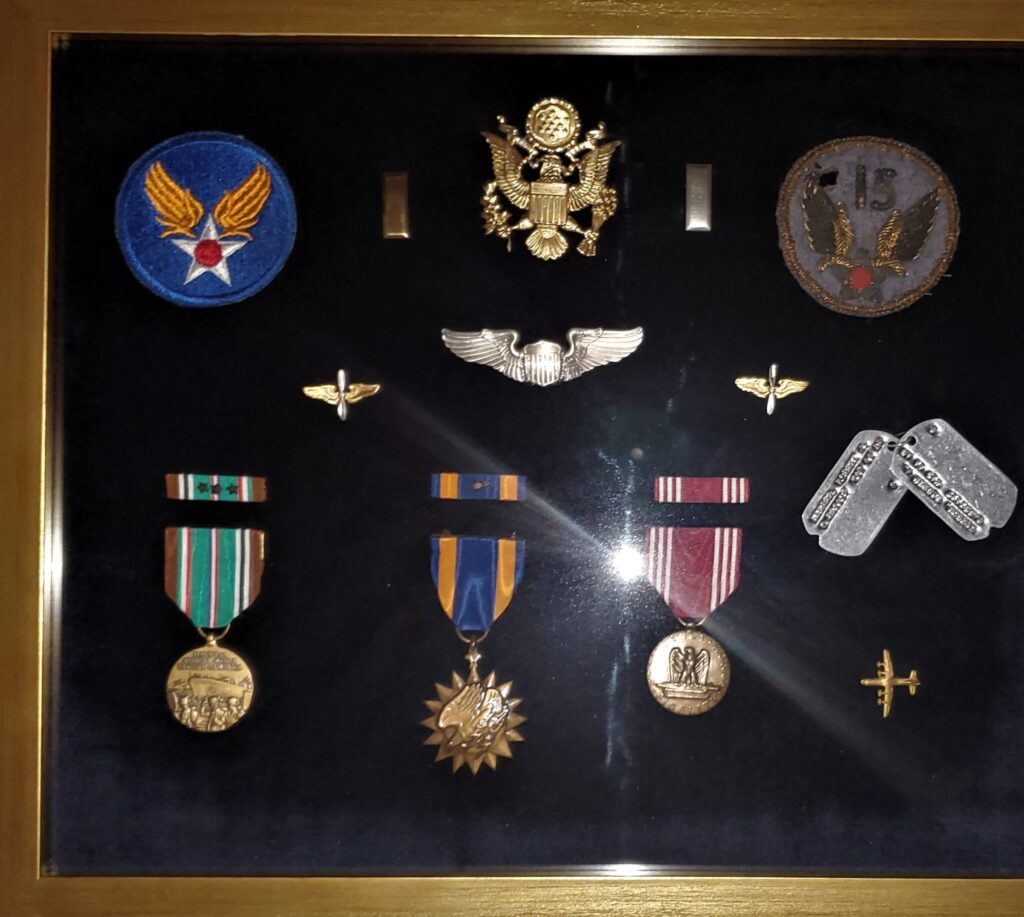
Robert always felt really good about what his squadron had done for the school that they supported there in Cerignola. Bob also said that as he was flying, he would look down and think how beautiful it was and that one day he would love to go and see it. He did so with Priscilla on his 25th wedding anniversary.
Bob wanted to stay in the military and to fly. He did many transport missions for the USAAC, but they had other plans for him. They wanted him to be an engineer since he had a college education; he said thanks, but no thanks, and got out. He wanted to be a scientist.
An excellent pdf history of the 484th can be read here.
For further research, please see: 484 bomber group
Also, direct inquiries about service personnel, etc. addresses are located here.
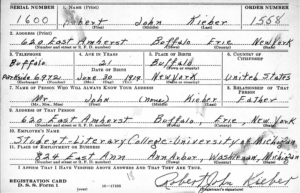
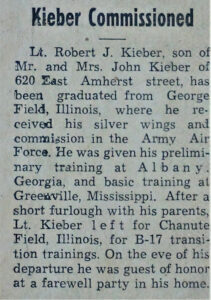
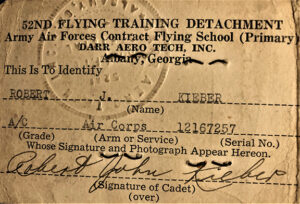
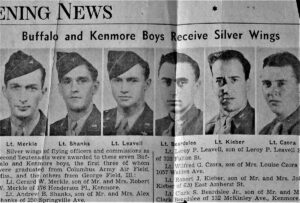
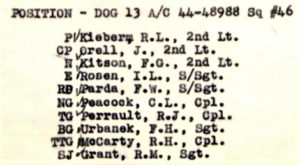
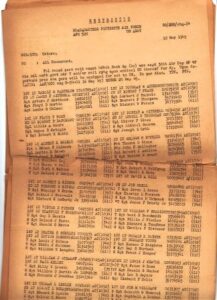
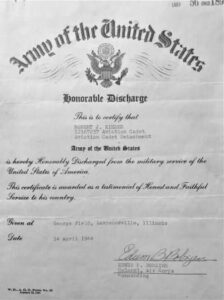
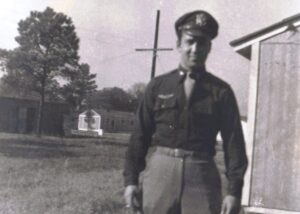
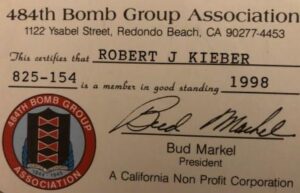
Leave a Reply